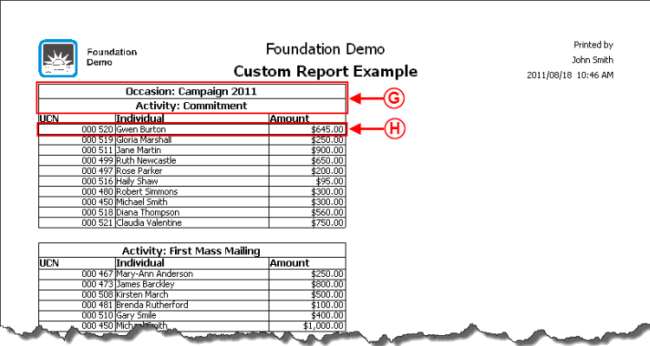Template:Header ProDon
Introduction
The custom reports tool allows you to create reports from a search conducted previously.
Firstly, it is important to know that:
- It is possible to create a custom report from all the management grids in which the report icon
 is active (blue).
is active (blue).
- A report is always attached to a precise management grid. For instance, if it is created in the "Transaction management", it doesn't appear in the "Client management".
- The fields available for the creation of a report are the same as the ones in the corresponding management grid (columns).
- It is possible to include summaries to the reports only from the "Client management" and "Analysis & History".
- Each management grid contains files (e.g. the client file in the "Client management" grid) and it is possible to generate an existing report from each of these files. However, it is not possible to create a new one.
Managing the Reports Available
First of all, go in the management proper to the type of report you want to create, modify or delete.
Click on the  button.
button.
|
This window opens.
|
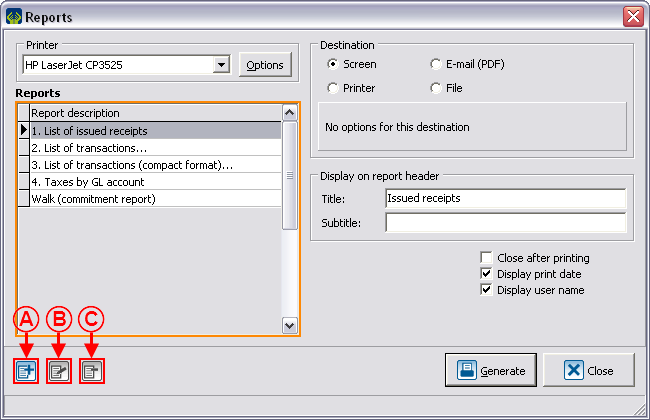
|
|
A: The  button allows you to create a new report. button allows you to create a new report.
|
B: The  button allows you to modify a report. button allows you to modify a report.
|
|
C: The  button allows you to delete a report. button allows you to delete a report.
|
NOTE: The reports provided by Logilys are not modifiable nor deletable.
|
Creation of a Custom Report
Go to the management proper to the type of report you want to create.
Conduct a search by criterion using the search bar, so that the management grid corresponds to what should be found on the report.
Once the management grid corresponds to what should be found on the report, click on the  button.
button.
To create a new report, click on the  button.
button.
|
This window opens.
|
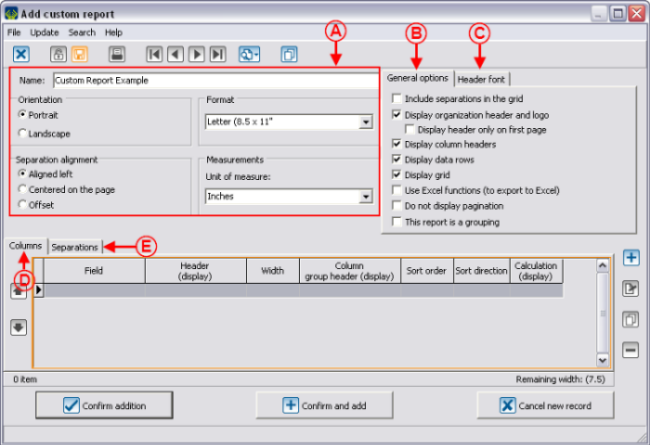
|
|
A: This section allows you to configure the visual options.
|
B: The "General options" tab allows you to configure the general option of the custom report.
|
|
C: The "Header font" tab allows you to choose the header font of the report.
|
D: The "Columns" tab allows you to add columns to the report.
|
|
E: The "Separations" tab allows you to add separations to the report.
|
|
Configuration of the Visual Options
|
For all the following examples concerning the visual configuration, refer to the section "Examples of Visual options".
|
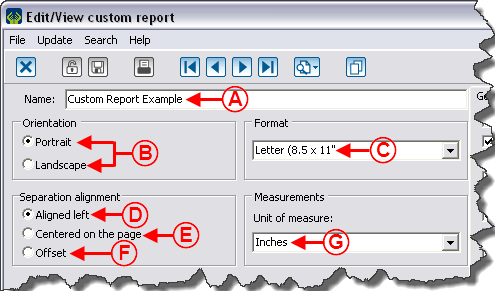
|
|
A: Allows you to name the custom report.
|
B: Allows you to decide whether the report will be generated in "Portrait" or "Landscape" orientation.
|
|
C: Allows you to choose on which paper format the report will be generated (e.g. 8,5 X 11", 8,5 X 14", etc.).
|
D: This option allows you to align the separations to the left. To view an example of left alignment, see letter B.
|
|
E: This option allows you to centre the separations alignment. To view an example of centred separation, see letter G.
|
F: This option allows you to offset the separations alignment. To view an example of offset separation, see letter I.
|
|
G: Allows you to choose the unit of measurement to be used for the width of the report columns.
|
|
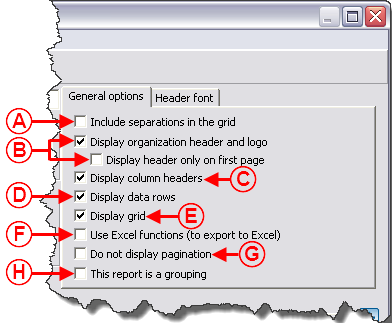
|
|
A: Allows you to include separations in the grid. To view an example of separation above the grid, see letter B. To view an example of separation in the grid, see letter G.
|
B: Displays the header and the logo of the organization on the first page only or on all the pages of the report. To view an example of header, see letter A.
|
|
C: Displays the header of the columns. To view an example of column header, see letter C.
|
D: Displays the data lines. To view an example of data lines, see letter D.
|
|
E: Displays the grid. To view an example of report with a grid, see letter E. To view an example of report without a grid, see letter J.
|
F: Uncheck this box if Excel sends an error message during the exportation.
|
|
G: If the box is checked, the pagination will be on the report. If the box is not checked, the pagination will not be displayed.
|
H: Activates the grouping option on the report. To view an example of report without the grouping option, see letter F. To view an example of report with the grouping function, see letter H. For more information concerning the grouping option, click here.
|
Examples of Visual Options
First Example
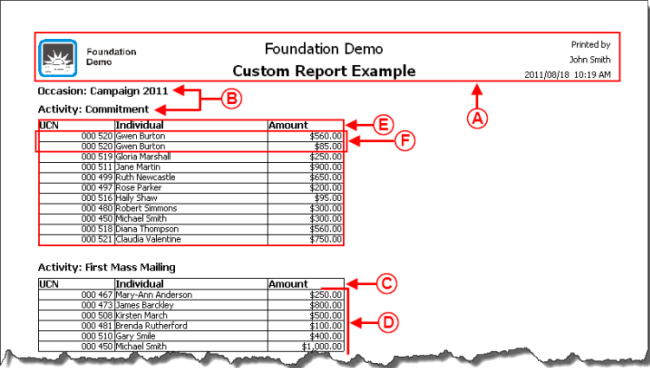
|
|
A: It is the header including the logo of the organization.
|
B: Example of report when the separations are aligned to the left and above the grid.
|
|
C: This line is a column header.
|
D: These lines are the data lines.
|
|
E: Example of report when the option "Display grid" is checked.
|
F: Example of report when the grouping option is not checked. If it had been checked, Mrs.Gwen Burton would have appeared only once and her two donations would be added. See the example in H for a grouped report. For more information concerning the grouping option, click here.
|
Second Example
Third Example
Adding Columns to the Report
Information on the Column
Display
Example of Display
Calculation on Column
Example of Calculation on Column
Adding Separations to the Report
Examples of Separations
Configurable Value
Example of Configurable Value
Conditional Value
Example of Report with a Conditional Value
Calculation Function
Example of the "Calculation Function" Field
Using the Option "This report is a grouping"
Example of an Onscreen Search
Result of the Onscreen Search
Document name: ProDon:Custom Reports
 is active (blue).
is active (blue). 
![]() button.
button.
![]() button.
button.
